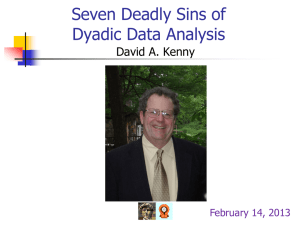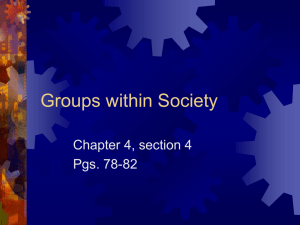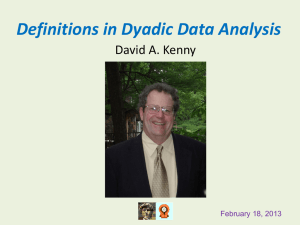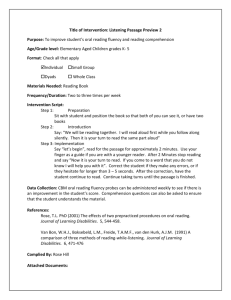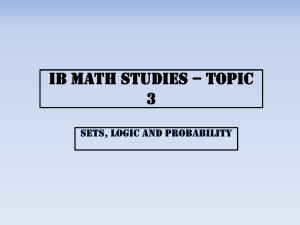HOW GOOD ARE STUDENTS AT CONVERTING
advertisement
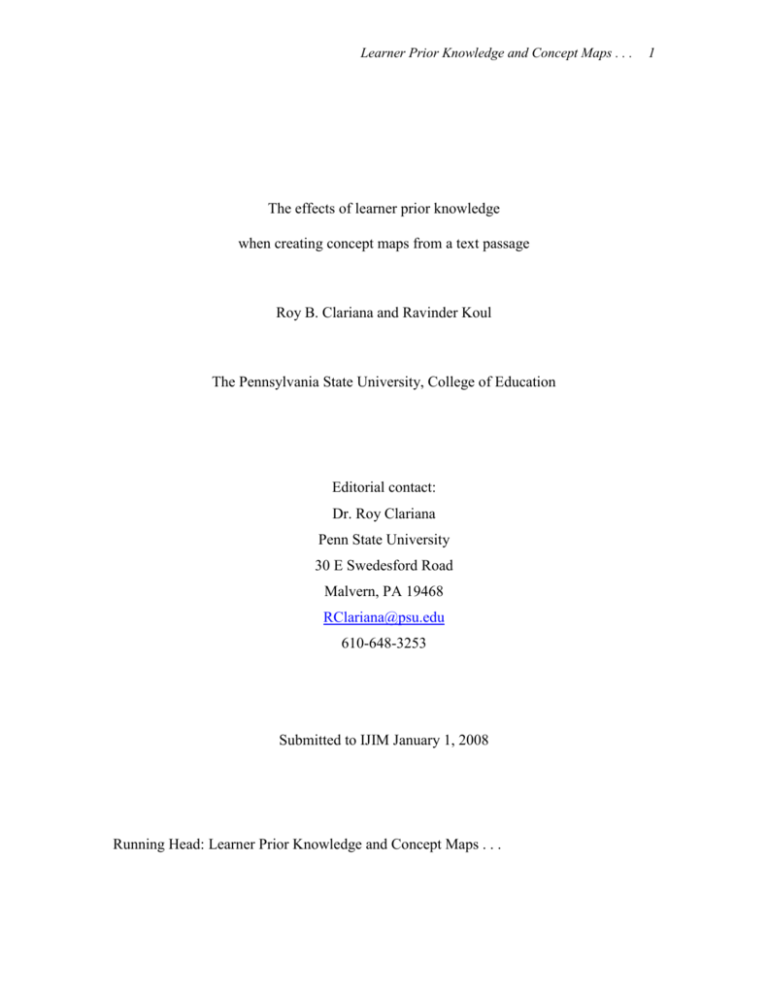
Learner Prior Knowledge and Concept Maps . . . The effects of learner prior knowledge when creating concept maps from a text passage Roy B. Clariana and Ravinder Koul The Pennsylvania State University, College of Education Editorial contact: Dr. Roy Clariana Penn State University 30 E Swedesford Road Malvern, PA 19468 RClariana@psu.edu 610-648-3253 Submitted to IJIM January 1, 2008 Running Head: Learner Prior Knowledge and Concept Maps . . . 1 Learner Prior Knowledge and Concept Maps . . . 2 The effects of learner prior knowledge when creating concept maps from a text passage Abstract Past practice has assumed a strong correspondence between concept maps and complementary text passages. To quantify and explore this correspondence, this investigation examines the average percent of agreement of multiple concept maps derived from one short text passage. Participants were 16 graduate-level students enrolled in a curriculum course. Participants worked in dyads to convert a 255-word text passage on the heart and circulatory system into a concept map of this content. Propositions in the eight resulting concept maps were analyzed using Pathfinder KNOT software. The correspondence between the eight concept maps and the text passage were only fair to poor. However, for the three dyads with a science major as a member, these concept maps corresponded more with each other (e.g., 61%, 65%, and 87% agreement), and also with the text passage (e.g., 46%, 52%, and 55% agreement). Thus prior knowledge may be critical in concept mapping and likely relates to selecting the most important concepts to include from the universe of concepts and also knowing when the map is completed. Concept maps and essays are a valuable tool for capturing and representing information (Jonassen, Beissner, & Yacci, 1993; Novak, n.d.; Novak & Gowin, 1984). For example, Jonassen et al. list concept maps as a common note-taking strategy for recording class lectures and textbook readings. Concept maps may be especially good for summarizing text (p.419, Nesbit & Adesope, 2006). Also, teachers advocate using concept maps in place of outlines for composing classroom essays and most concept mapping software (i.e., CmapTools tools and Inspirationtm) has a map-to-outline feature that allows students to automatically convert from a visual concept map to a hierarchical text outline that can then be used in the traditional way for composing an essay. Thus many teachers and researchers assume a tacit correspondence between concept maps and text passages. Learner Prior Knowledge and Concept Maps . . . 3 Further, the relationship between student essays and concept maps has been used for high-stakes assessment. In order to score the Connecticut state-wide examination, Lomask, Baron, Greig, and Harrison (1992) converted students’ essays of science content knowledge into concept maps, and then scored the concept maps using a quantitative rubric. Given these examples above, educators and researchers must sense a natural or tacit relationship between text and concept maps. This investigation asks a pragmatic question, how well do concept maps derived from a text passage correspond to each other and to the text passage? Method In order to examine the correspondence of complementary concept maps, we required multiple similar concept maps based on the same text passage. A group of education graduate students (N = 16) enrolled in a curriculum course that focuses on traditional and alternate assessment approaches assisted in this investigation as part of their regular course activities. The participants were asked to work in dyads because previous research suggests that dyads create better concept maps than do individuals (Nesbit & Adesope, 2006). Note that the participants in Dyads 1, 4, 5, 7 and 8 were all non-science majors while one of the members in each of the Dyads 2, 3, and 6 were science majors. As an overview of the topic, the dyads were given a list of 26 important terms and also an expert’s concept map of this topic (see Figure 1) that included 16 important terms and 16 propositions (i.e., labeled links). Following the approach used by Lomask, Baron, Greig, and Harrison (1992) but working in dyads, participants were given a 255-word student essay on the structure and function of the heart and circulatory system (see Table Learner Prior Knowledge and Concept Maps . . . 4 1) and were instructed to work together in their dyad to create a concept map using CmapTools software that accurately represented this text passage, not their own understanding of the topic. We used this approach in order to generate complementary concept maps for comparison purposes that are as similar as humanly possible. The dyads were provided with ample time during class to complete this activity. Table 1. The 255-word text passage. Heart Essay By Student 6 The circulatory system consists of an intrinsic network of veins, arteries, capillaries, blood vessels, and body tissues providing the human body with nutrients, oxygen, hormones, and other substances while collecting body waste and transporting it to the kidneys and lungs for removal. The heart receives blood from the body and pumps it into the lungs where it receives oxygen before it is returned to the heart. The heart is a muscular organ divided into two sides separated by a wall called the septum. Each half of the heart contains two chambers: a smaller, thin-walled, upper chamber called the atrium and a larger, thick walled, lower chamber called the ventricle. The atrioventricular valves separate the atrium and the ventricles. The circulation of blood follows a distinct one directional path controlled by these valves. Blood from the body enters the right atrium of the heart by way of the superior and inferior vena cava. These vena cava return blood from the upper and lower extremities respectively. Blood passes from the right atrium into the right ventricle through the tricuspid valve. Contractions in the right ventricle force blood into the pulmonary artery, which carries it into the lungs. Blood is oxygenated and wastes are cleansed. Once oxygenated, it returns to the left atrium through the left and right pulmonary veins. Finally, the mitral valve pushes the blood into the left ventricle and then to all parts of the body by way of the largest artery, the aorta, which branches into the neck, arms, lower body organs, and legs. Figure 1. The expert concept map of this topic in CmapTools. Learner Prior Knowledge and Concept Maps . . . 5 Using Pathfinder KNOT to Analyze Concept Maps This investigation used an approach described by Clariana, Koul, and Salehi (2006) for comparing text passages and concept maps. First, each dyad’s concept map was saved as a proposition text file using the Export-Cmap-As feature in the CmapTools (2007) file menu. Next, the Mark S feature in ALA-Reader (2007) software was used to convert the CmapTools proposition-as-text files directly into KNOT proximity files (Clariana & Koul, 2004). The ALA-Reader software was given the following list of 23 important terms: aorta, aortic valve, body (or extremities), capillaries, deoxygenated blood, exchange, left atrium, left ventricle, lungs, mitral valve (or atrioventricular), nutrients, organs, oxygenated blood, pulmonary artery, pulmonary valve, pulmonary veins, pump (or contract or systolic), removes waste (or cleanses), right atrium, right ventricle, tissue, tricuspid, and vena cava. Last, the proximity files were opened and analyzed using the KNOT (1998) software (see Figure 2). In addition, the 255-word text passage was also converted by ALA-Reader into a proximity file. Figure 2. A mock concept map (left), the CmapTools propositions text file of this map (center), and the proximity array file generated by ALA-Reader from this text file (right). The proximity files were converted to network files and then analyzed by KNOT software. The software used the same list of 23 important terms as did the ALA-Reader software, and in this analysis, the values for Minkowski’s r were infinity and q was equal Learner Prior Knowledge and Concept Maps . . . 6 to 25 (e.g., n - 1). In the analysis, each dyad’s concept map network was compared to every other dyad and to the 255-word text. How can two networks be compared? A common measure of similarity or correspondence between two networks is configural similarity (C), a set-theoretic measure of node similarity (Goldsmith & Davenport, 1990) that ranges from 0 (no similarity) to 1 (perfect similarity). However, values of C in our opinion do not provide an easy to understand measure of the correspondence between two networks. Thus a new measure called “average percent of agreement” was fashioned by dividing the number of links in common by the average number of links in the two networks. For example, given two networks named a and b; average percent agreement = a|b links in common divided by (a total propositions + b total propositions) divided by 2. The following example using actual data from this investigation explains in more detail this average percent of agreement approach. Given the concept map data for dyads 1 and 2, the concept maps of Dyad 1 (with 18 total propositions) and Dyad 2 (with 22 total propositions) have 2 propositions in common. The percent of Dyad 1’s concept map propositions that are shared with Dyad 2 is 11.1% (i.e., 2/18 = 11.1%) and the percent of Dyad 2’s concept map propositions that are shared with Dyad 1 is 9.1% (i.e., 2/22 = 9.1%). If you average 11.1% and 9.1% you obtain 10.1%. In our opinion, 10.1% is an understandable and reasonable estimate of the average percent agreement of the propositions in this pair of concept maps. Results First, considering the total propositions without regard to average percent agreement, note that the 255-word text passage contained 23 terms and 28 propositions Learner Prior Knowledge and Concept Maps . . . 7 and the expert map provided to the dyads ahead of time contained 16 terms (concepts) and 16 propositions (see Figure 1). Thus it was anticipated that the dyad concept maps would contain between 16 and 28 propositions. Contrary to expectations, the eight dyads produced quite different numbers of propositions ranging from a low of 3 to a high of 22 propositions. The non-science majors generally had few propositions in their concept maps while the dyads with a science major had more propositions, except for Dyad 1 (non-science) with 18 propositions (see Table 1). Table 1. The average percent of agreement for each pair of concept map networks (the number of network propositions are shown in parentheses). Dyad 1 (18) Dyad 4 (3) Dyad 5 (6) Dyad 7 (13) Dyad 8 (9) Dyad 2* (22) Dyad 3* (11) Dyad 6* (12) Non-science majors D1 D4 D5 D7 D8 -0% -0% 22% -7% 38% 11% -0% 0% 0% 0% -10% 0% 36% 11% 0% 7% 18% 24% 8% 0% 7% 0% 22% 8% 0% Text (28) 13% 13% Expert map (16) 12% 0% * dyads with a science major 6% 9% 24% 5% 14% 8% Science major D2* D3* D6* -61% -65% 87% Text -- 52% 46% 55% 58% 59% 64% -71% Next, considering the average percent of agreement between the pairs of dyad concept map networks, since the concept maps were all derived from the same 255-word text passage it was anticipated that the maps would be quite similar. However, this was not the case (see Table 1). The average percent agreement between each dyad concept map (an objective measure of the quality of the dyad maps, in terms of concept links Learner Prior Knowledge and Concept Maps . . . 8 only) and the 255-word text were only fair to low, ranging from 5% to 55%. The concept maps of those dyads with a science major (Dyads 2, 3, and 6) showed the greatest correspondence with the 255-word text, and Dyad 2 had the largest average percent agreement with the 255-word text passage (e.g., 55%). In comparing the dyad concept maps to each other, the science major dyads’ concept maps were most similar to each other (61%, 65%, and 87%). For the non-science dyads, the average percent agreement values were considerably lower (from 0% to 38%). Each dyad’s concept map was also compared to the expert map that was provided to the dyads during the mapping task. Note that there is a 71% average agreement between the text passage and the expert concept map. As above, the dyads with a science major produced concept maps of the 255-word text that were more like the expert map (from 58% to 64%) than did the non-science dyads (from 0% to 14%). Further analysis indicates that the quality of each dyad’s concept map network is not related to the number of propositions in their concept map (see Figure 3). This scatter graph shows that the dyads with science majors were more accurate and a little more thorough at translating text propositions into concept map propositions. Apparently, prioritizing the importance of information to include in a concept map and knowing when the mapping task is done are critical tasks in concept map creation. Percent Agreement with the 255-word text Learner Prior Knowledge and Concept Maps . . . 9 80% 70% Expert map D6* D3* 60% D2* 50% 40% 30% 20% D7 D5 10% D8 D1 D4 0% 0 5 10 15 20 25 Number of Concept Map Propositions Figure 3. The relationship between the number of propositions in the dyad concept maps and the average percent agreement with the 255-word text passage (* shows dyads with a science major). Discussion This investigation considered the correspondence between a science text passage and participant-derived concept maps of that passage. The methodology was designed to produce a high correspondence by using a relatively simple and short text passage (i.e., only 255 words), by providing ahead of time a simple and clear expert concept map of the correct content, by providing a list of important terms, by providing ample time to complete the concept mapping task, and by embedding the task in an authentic setting. However, there was a low correspondence between the maps and the text passage, and also between the various maps except for the three dyads with science content members. In the epigraph to Educational Psychology: A Cognitive View, Ausubel (1968) says, “The most important single factor influencing learning is what the learner already knows.” The results of this investigation indicate that learner’s prior knowledge had a very strong Learner Prior Knowledge and Concept Maps . . . 10 influence on their concept maps. This suggests that prior content knowledge may be an especially critical factor in concept mapping, perhaps due to the sparse nature of the representation artifact. The method for analyzing proposition agreement is a limiting factor in this investigation. The selection of terms used to analyze propositions will favor one concept map over another since some maps will have some terms and not others. However, in this case the 23 words used in the Pathfinder analysis approach were all taken from the longer list of terms given to the dyads during the mapping task and in addition, the 23 terms included all 16 terms contained in the expert concept map provided during the mapping task. The important terms were provided, and given the important terms the propositions are explicit in the text passage. If dyads had selected more important terms and propositions (though fewer in total), their maps would be more alike, however this was not the case. The non-science dyad maps were not alike which indicates that the propositions included in the various maps were idiosyncratic. His means that there was no apparent regard for which terms and propositions in the text were more critical than others. This further reinforces the importance of prior knowledge in concept map creation, knowing both breadth and relative importance of the content elements even when the task is simply to convert a text to a concept map. In their study on the impact of subject matter (content) knowledge on teaching, Hashweh (1987) found that teachers could list many methods and ideas for teaching concepts in their specialty areas but showed misconceptions and misunderstandings about content knowledge in the field that is not their major field. In this investigation, the Learner Prior Knowledge and Concept Maps . . . 11 quality of the concept maps appears to be strongly related to the participants’ domain knowledge of science. Dyads 2, 3 and 6 with one science major in each dyad were more accurate and thorough in translating text propositions into concept map propositions. Thus teachers may be less accurate when converting an essay into a concept map if the content of the essay is outside their area of specialty; and this further begs the question regarding whether a non-expert can evaluate a concept map. In this investigation, prior knowledge had a much greater effect on concept map propositions (links) than would be expected, and this may generalize to any instructional uses of concept maps. References ALA-Reader (2007). Analysis of Lexical Aggregates-Reader, software version 1.0. Downloaded December from http://www.personal.psu.edu/rbc4/score.htm Ausubel, D. (1968). Educational psychology: a cognitive view. New York, NY: Holt, Rinehart and Winston. Clariana, R.B., & Koul, R. (2004). A computer-based approach for translating text into concept map-like representations. In A.J.Canas, J.D.Novak, and F.M.Gonzales, Eds., Concept maps: theory, methodology, technology, vol. 2, in the Proceedings of the First International Conference on Concept Mapping, Pamplona, Spain, Sep 14-17, pp.131-134. Downloaded April 9, 2006 from http://cmc.ihmc.us/papers/cmc2004-045.pdf Clariana, R.B., Koul, R., & Salehi, R. (2006). The criterion-related validity of a computer-based approach for scoring concept maps. International Journal of Instructional Media, 33 (3), 317-325. CmapTools (2007). A free concept mapping software tool available form the Institute for Human and Machine Cognition (IHMC). Downloaded December 29, 2007 from http://cmap.ihmc.us/ Goldsmith, T.E., & Davenport, D.M. (1990). Assessing structural similarity in of graphs. In Schvaneveldt (ed.), Pathfinder associative networks: studies in knowledge organization, 75-87. Norwood, NJ: Ablex. Hashweh, M. Z. (1987). Effects of subject matter knowledge in the teaching of biology and physics. Teaching and Teacher Education, 3, 109-120. Learner Prior Knowledge and Concept Maps . . . 12 Jonassen, D. H., Beissner, K., & Yacci, M. (1993). Structural knowledge: techniques for representing, conveying, and acquiring structural knowledge. Hillsdale, NJ: Lawrence Erlbaum Associates. KNOT (1998). Knowledge Network Organizing Tool (v.1.0). See http://interlinkinc.net/KNOT.html Lomask, M., Baron, J., Greig, J., & Harrison, C. (March, 1992). ConnMap: Connecticut's use of concept mapping to assess the structure of students' knowledge of science. A symposium presented at the annual meeting of the National Association for Research in Science Teaching, Cambridge, MA. Nesbit, J. C., & Adesope, O. O. (2006). Learning with concept and knowledge maps: A meta-analysis. Review of Educational Research, 76, 413–448. Novak, J. D. (n.d.). The theory underlying concept maps and how to construct them. Downloaded April 9, 2006 from http://Cmap.coginst.uwf.edu/info/printer.html Novak, J. D. & Gowin, D. B. (1984). Learning how to learn. Cambridge, MA: Cambridge University Press. Schvaneveldt, R. W. (Editor) (1990). Pathfinder associative networks: Studies in knowledge organization. Norwood, NJ: Ablex Publishing. Learner Prior Knowledge and Concept Maps . . . 13 January 1, 2008 Dr. Phillip J. Sleeman 149 Goose Lane Tolland, CT 06084 PLSleeman@aol.com Phone: 860-875-5484 Dear Dr. Sleeman, Here is a manuscript for IJIM, “The effects of learner prior knowledge when creating concept maps from a text passage”. This is an original unpublished experimental investigation that is not under consideration by another journal. We have followed APA reference standards, and will reformat as required. Sincerely, Dr. Roy B. Clariana Penn State Great Valley 30 East Swedesford Road Malvern, PA 19355 E-mail: RClariana@psu.edu phone: 610-648-3253
